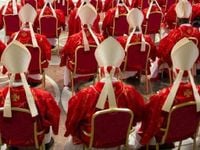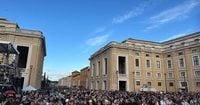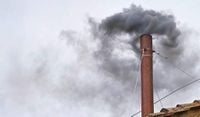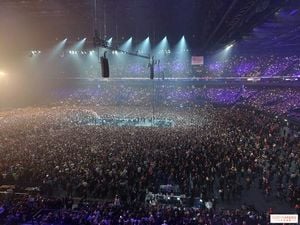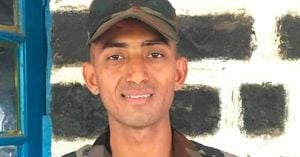On May 7, 2025, the eyes of the world turned to the Vatican as the Conclave officially commenced to elect the new Roman Pontiff following the passing of Pope Francis. The atmosphere was charged with anticipation as 133 cardinal electors gathered in the Sistine Chapel, ready to embark on the sacred process of selecting the 267th Pope in history.
The day began at 10:00 AM in St. Peter's Basilica with the Mass Pro eligendo Romano Pontifice, presided over by Cardinal Giovanni Battista Re, the dean of the College of Cardinals. This solemn liturgy served as a spiritual foundation for the cardinal electors, invoking the guidance of the Holy Spirit. Approximately 5,000 faithful attended the Mass, witnessing the cardinal electors, clad in their distinctive red vestments, as they gathered for this momentous occasion.
As the clock struck 4:15 PM, the cardinal electors processed into the Pauline Chapel, led by Cardinal Pietro Parolin, the most senior cardinal by appointment. They sang the hymn 'Veni, Creator Spiritus' to invoke the Holy Spirit's intercession in their deliberations. Shortly after 4:30 PM, the cardinal electors entered the Sistine Chapel, where they would remain isolated from the outside world for the duration of the Conclave.
At 5:46 PM, the doors of the Sistine Chapel were sealed, marking the official start of the Conclave with the pronouncement of "Extra Omnes" by Archbishop Diego Ravelli, the Master of Pontifical Liturgical Celebrations. This Latin phrase, meaning "Everyone Out," cleared the chapel of all non-participants, ensuring the secrecy of the election process.
In preparation for the voting, the cardinal electors took an oath to uphold the Apostolic Constitution and maintain absolute secrecy regarding their discussions and decisions. This oath is crucial, as any breach could lead to automatic excommunication. The cardinal electors then took their places at tables adorned with red drapes, ready for the first vote.
The voting process is governed by the Apostolic Constitution 'Universi Dominici Gregis', established by Pope John Paul II in 1996 and later amended by Pope Benedict XVI in 2013. According to these rules, a candidate must receive two-thirds of the votes to be elected Pope. If the required majority is not achieved, the ballots are burned, producing black smoke, while a successful election results in white smoke signaling the appointment of a new Pope.
As for the voting schedule, the first fumata was expected on the evening of May 7, not before 7:00 PM, as confirmed by Matteo Bruni, the director of the Vatican press office. Subsequent votes will take place twice daily, with the potential for two fumate each day: one in the morning at 10:30 AM (only if white) or at noon, and another in the afternoon at 5:30 PM or around 7:00 PM.
During the Conclave, all communication with the outside world is strictly prohibited for the cardinals. They cannot read newspapers, watch television, or engage in any correspondence. This isolation ensures that the cardinal electors can focus entirely on their sacred duty without external influences.
The cardinal electors, representing 71 countries, include 52 Europeans, 37 Americans (16 from the USA, 4 from Central America, and 17 from South America), 23 Asians, 17 Africans, and 4 Australians. Notably, the youngest cardinal is Mykola Bychok, 45, from Australia, while the oldest is Carlos Osoro Sierra, aged 79.
In addition to the voting, the cardinal electors will participate in daily Mass and recite the Liturgy of the Hours, which includes the morning prayers, Lauds, and the evening prayers, Vespers. The process of electing a new Pope is steeped in tradition and solemnity, reflecting the deep significance of this moment in the Catholic Church.
As the day progressed, the anticipation grew for the first fumata. If the smoke is black, it will indicate that no candidate has received the required votes, and voting will continue. However, if the smoke is white, it will signal the election of a new Pope, a moment eagerly awaited by Catholics around the world.
In preparation for the fumata, the ballots will be burned in a cast iron stove specifically designed for this purpose. The stove measures approximately one meter in height and 45 centimeters in diameter. To ensure the visibility of the smoke, an auxiliary smoke generator has been introduced, allowing for clearer signals to the public regarding the election's outcome.
Following the acceptance of the election, the new Pope will retreat to the 'Room of Tears' in the Sistine Chapel, a space where many have been moved to tears upon realizing the weight of their new responsibilities. After donning the papal vestments, the new Pope will read a passage from the Gospel of Matthew and receive the homage of the cardinal electors.
Finally, the moment will arrive when the cardinal protodeacon announces to the world, "Habemus papam," followed by the name of the newly elected Pope. This declaration will mark the beginning of a new papacy, as the new Pope steps onto the balcony of St. Peter's Basilica to impart his first blessing to the faithful gathered below.
The Conclave is not merely a procedural event; it is a profound spiritual journey for the cardinal electors, who seek the guidance of the Holy Spirit in selecting a leader for the global Catholic community. As the world watches, the hope is that the next Pope will lead with wisdom, compassion, and a commitment to the teachings of Christ.
